| Overview |
The Audit Report allows you to define an "audit cycle/frequency" for Vendors and Items and provide alerts when such objects are due for audit/review.
The Audit Report depends on 2 key attributes assigned to Vendors and/or Items.
| Last Audit Date |
A date/time attribute that defines the last time the object was reviewed/audited |
| Audit Frequency |
Frequency (in number of days) that the object is to be reviewed/audited |
These attributes can be any attributes.
The report allows you to dynamically assign which attributes should be used for each object.
Note: the report will only include objects with values assigned to the Audit Frequency report.
|
 |
Launching the Audit Report |
Top |
|
You can open the Audit Report from the Reporter Home Page.

The Audit Report contains 2 main areas:
| Report Options |
Specify the object type, audit attributes, filter fields, and advanced options |
| Search Results |
Displays all objects that meet the search criteria, displays pending and overdue objects with different colors |

|
 |
Selecting an Object Type |
Top |
|
To select which audit objects (Vendors or Items) you wish to display, select the desired object from the Object list.

Selecting the object type will update the Attributes and field options lists.
|
 |
Audit Attributes |
Top |
|
The Audit Report depends on 2 key attributes assigned to Vendors and/or Items.
| Last Audit Date |
A date/time attribute that defines the last time the object was reviewed/audited |
| Audit Frequency |
Frequency (in number of days) that the object is to be reviewed/audited |
These attributes can be any attributes.
Once the Object type is selected, the attributes list will display the available attributes for that object.

To execute the report, you must specify both the Last Audit Date and Audit Frequency attributes.
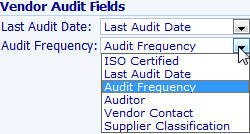
The report assumes that the attribute assigned to the Last Audit Date field is a Date/Time format,
and that the Audit Frequency field is a numeric value representing the number of days between each audit/review cycle.
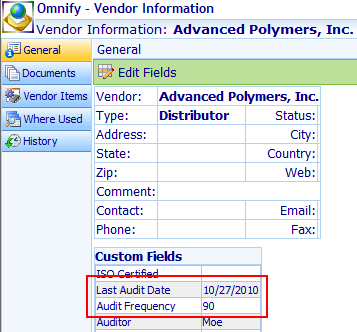
The attributes will be displayed in the results table and the report will calculate the due and overdue objects based on those values.

|
 |
Search Results |
Top |
|
Once all attributes and options have been defined, click the Run Report button to display the results.
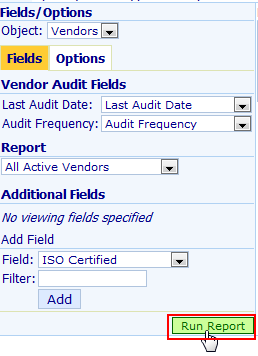
The audit attributes will be displayed in the results table and the report will calculate the due and overdue objects based on those values.
The report will also calculate the number of days until the next audit as well as the next audit date.

Results will display different colors based on due and overdue items.

|
 |
Viewing/Filtering Fields |
Top |
|
You can provide additional fields to view and/or filter on to the report.
To add a field, select the field from the Add Field area.
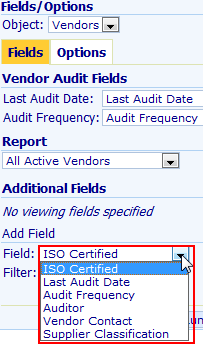
Once the field is selected, click the Add button to add the field.

The field will now appear in the list.
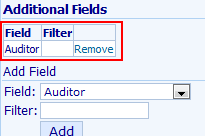
When the report is executed, the field will appear in the results table.

You can filter the results based on other attribute values by specifying a filter value for the field.
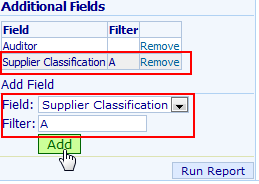

|
 |
Report Options |
Top |
|
In addition to the attribute filters, you can also define additional options to refine the results.
The Report drop list provides filtering of:

| All Active Objects |
Displays all objects that contain values in the Last Audit Date field |
| Objects Overdue for Audit |
Display only those objects that are overdue for audit |
| Objects Requiring Audit |
Displays only those objects that are due for audit in the next n days (n is defined in options).

|
| Recently Audited Objects |
Displays only those objects that have been audited in the last n days (n is defined in options).

|
Additional options can be specified by selecting the Options tab.

From this tab, you can filter vendors based on their status and/or type.
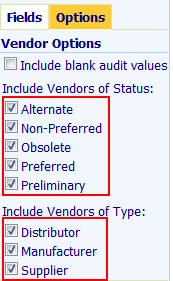
|